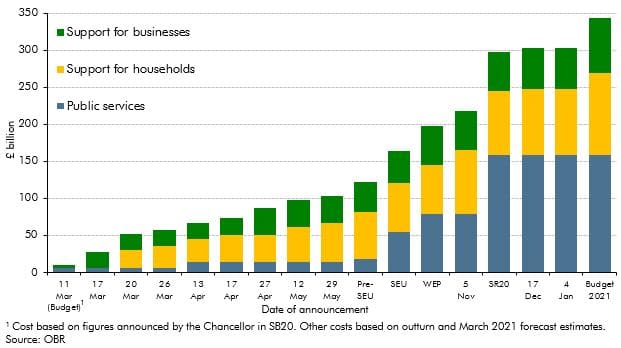In the March 2021 EFO we estimated that policy measures responding to the coronavirus pandemic would add £344 billion to borrowing, with these policies announced across a number of statements beginning alongside the March Budget. This box updated on our estimate of this cost from November and the relative shares of support going to households, businesses and for public spending.
This box is based on OBR data from March 2021 .
In our November EFO we described the evolution of the Government’s fiscal policy response to the pandemic, whose total cost in 2020-21 had increased from the £12 billion announced in the March Budget to £280 billion by the November Spending Review, via twelve ‘mini-Budgets’ through the course of the year. At the Spending Review, the Chancellor also announced £55 billion of additional virus-related funding for public services in 2021-22. All told, the total cost of virus-related support measures across the forecast period in November (including the small number that have lasting effects beyond 2021-22) was £337 billion. But we anticipate some underspending by departments relative to the large increases in plans at the Spending Review, so the expected cost was somewhat lower at £331 billion.
Since November there have been three further policy announcements:
- On 17 December, the extension of the CJRS by one month to the end of April and the government-backed loan schemes by two months to the end of March.
- On 5 January, £4.6 billion in grants to businesses affected by the third nationwide lockdown, and a £594 million discretionary fund for other affected businesses. (This was funded from within existing allocations, so does not add to total cost of support.)
- This Budget includes a further £3 billion in virus-related support in 2020-21 and £43 billion in 2021-22, most notably the extensions of the CJRS and SEISS.
Taken together, these latest announcements add £44 billion to the total cost of the support measures since the start of the pandemic. But the overall cost has risen by a much smaller £8 billion relative to our November estimate, to stand at £344 billion. That reflects several interventions costing less than expected in 2020-21, lowering our estimate of the total cost of measures announced up to the Spending Review from £331 billion to £300 billion.
In particular, virus-related spending on public services in 2020-21 has been revised down by £11 billion (largely due to somewhat less rapid growth in health spending) and by £6 billion in 2021-22. The CJRS is now expected to cost £3.5 billion less in the period up to March than we assumed in November, while the SEISS and government-backed loan schemes also cost less than expected.
Chart A repeats the running total we presented in November, but this time based on the totals costs of announcements across the forecast period. It is based on revised costs of previous announcements to reflect our latest estimates and adds the new announcements since November. It shows that support for public services accounts for 46 per cent of the total at £158 billion. The majority of this is on health, including the cost of personal protective equipment, NHS Test and Trace, and the procurement and rollout of vaccines. Support for households accounts for 32 per cent of the total at £111 billion, of which 81 per cent comes via the CJRS and SEISS. Finally, support for businesses makes up the remaining 22 per cent at £75 billion. This cost is dominated by grants and business rates holidays, and the upfront recording of expected write-offs relating to the government-backed loan schemes.
Chart A: Total cost of successive virus-related policy announcements

This box was originally published in Economic and fiscal outlook – March 2021
